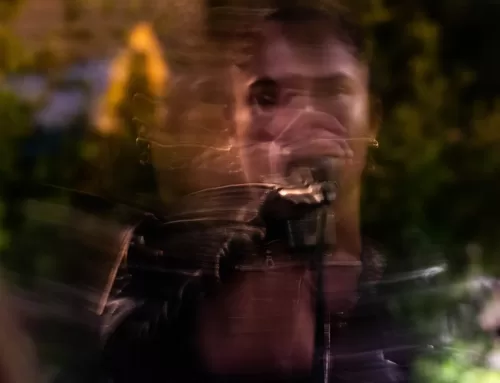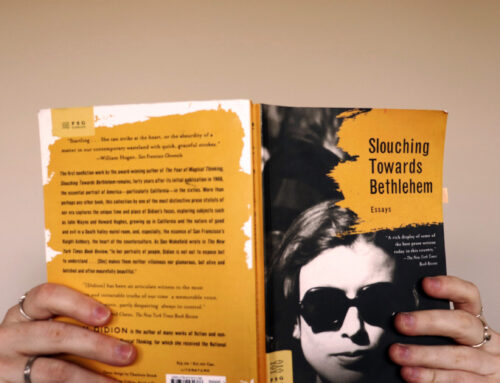
About halfway through Miranda July’s latest novel All Fours, I started to get a sinking feeling. Was this “surprising,” “boundary-pushing tour-de-force” ultimately about a man with a downy little mustache?
The protagonist—an anonymous “semifamous” artist who embarks on a cross-country road trip in order to become the sort of “chill, grounded” woman who can handle a cross-country road trip—makes it forty-five minutes before checking into a motel in Monrovia, where she stays for two weeks.
There, she falls in love with Davey, a younger, lightly mustachioed Hertz employee and, despite mentions of queerness—an ex-girlfriend, her best friend Jordi’s lesbian marriage, her non-binary child Sam—we begin to suspect the narrative will conform to a typical hetero plot-or-not: Will our protagonist return happily to her husband, or will the man from Monrovia ruin her relationship?
The near-affair inevitably ends. The protagonist goes home to what her father calls a “deathfield” of mourning and panic. She “grits” through domestic life and rewards herself with incessant fantasizing about her two-week escape. The narrative seems to cede its driving force to the question of I do or I don’t, I can or I can’t.
Then, our protagonist receives a diagnosis: perimenopausal. “We’re about to fall off a cliff,” she tells Jordi, reading a chart on women’s libido after menopause.
The irony hits hard: just as the possibility of embodied desire—being “a body wanting a body”—opens, it ends. Like the protagonist, I began to accept that this story might be a cautionary tale against learning too late, a story about one woman’s futile “sexual frenzy,” of desire’s final flourish.
And here returned my sinking feeling—I’d read stories like this before. In her article for Lux, Emma Copley Eisenberg explains the phenomenon of “The Unhinged Bisexual Woman Novel,” where “everything is a joke, love is for suckers, and gay liberation is a bore.”
These novels, Eisenberg explains, feature “credulity straining plots” and “unstable” protagonists who are often called “madcap,” “a riot,” “off kilter,” or “strange” by critics. Their desire, and queer desire in particular, is “another zany life choice,” void of “romantic or erotic or, god forbid, political meaning… evidence of the female protagonist’s emotional incoherence.”
Big Swiss and Milk Fed, the two novels Eisenberg analyzes, share company on TikTok with Naosie Dolan’s Exciting Times, Ottessa Moshfegh’s My Year of Rest and Relaxation, and, I’d add, a sampling of Sally Rooney—most of which are circulated via hashtags like #unhingedwomen or #sapphicbooks, which have over 35 million and 190 million respective views.
Despite their “unhinged” reputations, the women protagonists of these novels seem unwilling or unable to allow queer politics to restructure their relational paradigms, or vice versa.
They are “characterized by a kind of mean, dry, deadpan first-person voice that communicates to the reader that the protagonist views herself as exempt from the embarrassing task of being a human being,” Eisenberg writes.
They can talk and joke about sex and politics, but they can’t have either without alienating themselves.
When Greta, the 45-year-old protagonist of Big Swiss, has sex with a younger gynecologist named, well, Big Swiss, the scene fixates on disembodied genitals that are “obfuscated with odd metaphors,” including “advanced origami,” “a crisp pink lotus flower,” and a unicorn. “Big Swiss cannot be just a woman with a body that Greta wants to touch; her pussy must look like anything but what it is,” Eisenberg writes.
Some authors, like Sally Rooney, don’t show queer sex at all. “Rooney struggles to find the line between over-sexualizing lesbian relationships and invisibilizing them,” Annabel Barry writes in “Sally Rooney’s Love Plot as Gimmick.” Bisexuality, for Rooney’s characters, often operates “as a hypothetical, rather than an actual desire: one that might complicate her character’s dilemmas or provoke tension but never materializes as a valid choice for living,” Natalie Adler argues in “Bisexual World, Where Are You?”.
In Beautiful World, Where Are You?, Alice and Eileen exchange emails of “fluent academic Marxist critique.” Isolated in separate chapters, the emails sit outside the story’s action, “[allowing] its conventional romantic plotline to still advertise itself as a placating fantasy,” Barry writes.
The emails offer not only a “veneer of political engagement,” but a veneer of engagement with queer experience. They allow the protagonists to “always talk past each other, to address their own insecurities more than each other,” as Adler claims. By living out their identities only in ideology, the two bypass queer community, and the risks and rewards of just fucking and finding out.
“The Unhinged Bisexual Woman Novel is, at its core,” Eisenberg explains, “a story about self-protection, about protagonists insulating themselves from death and loneliness, from going too far and falling off the edge of the world.”
In All Fours, the estrogen cliff means the world to our protagonist. Which is why, when she hurtles over its edge, the book turns into truly novel territory.
In attempting to seduce Davey into returning, the protagonist falls into bed with—gasp—a woman. “I walked with giant strides and marveled, almost laughing, that I’d actually had sex with someone,” she exclaims.
Here, fantasy fades, and the protagonist lands in a new reality, stating:
I’d thought the two paths were:
sex with Davey vs. a life of bitterness and regret
But maybe the road split between:
a life spent longing vs. a life that was continually surprising
The difference is key. At the end of Big Swiss, Eisenberg explains, Greta longs to enter a “queer restaurant” but decides she’s not gay enough. The story returns to a status quo of desire and denial.
In the coda to Beautiful World, Eileen emails Alice, describing the comforts of home life with her husband Simon. However, by calling even Simon’s “paternalistic beliefs about women” “charming,” she reveals the love plot not as a “saving inoculation from structural oppression,” but a gimmick.
Gimmicks are, at their core, contradictions, Barry explains: they “strike us as working too little (labor-saving tricks) but also working too hard (strained efforts to get our attention).” They solicit a confusing range of affective responses—things “we hate to love and love to hate”—by exposing the flimsiness of the fantasies they claim to espouse.
“For all her investment in creating bisexual characters, [Rooney] seems unfamiliar with the trope of the primarily heteroromantic bisexual cis woman whose insecurity about not being queer enough keeps her from queer intimacy. I assume she isn’t using the right social media applications,” Adler writes.
But Beautiful World’s love plot might read as a gimmick precisely because of its ties to social media. While #BookTok skyrocketed sales for so-called #sapphicbooks and #unhingedbisexual literature, it also helped to homogenize queer content. “What kinds of queer stories get plucked from literary obscurity and sold to mainstream, straight audiences?” Eisenberg asks. “Those that satisfy straight appetites, of course.”
Looking again at All Fours, the hints of queerness I sensed from its beginning feel less performative and more integrated into a larger cosmos in which queer identity, sexuality, politics, and community interplay and coexist.
A beautiful, bisexual world.
The real show was the one our protagonist lamented all along, sneaking around her home “like a thief” and strapping on heels to have sex with her husband.
When the protagonist meets Audra, the rules of performance flip. She attempts to reenact her dreams of Davey and ends up in bed instead with a real human woman. The sex is buoyantly graphic, filled with skin texture, cum texture, gripping, cupping, squeezing, and “trying to put it all in my mouth.”
However, the description also repeats the same sizeist traps that Eisenberg bemoans. After saying earlier that the older woman wasn’t “even my type” and that she had never touched anyone “this big and rounded,” the protagonist continues to harp on Audra’s “enormous ass” and “big arms.”
“Given my personal investment, I wanted to make her come,” she says. The quip deflects her desire, casting it as more of a curiosity than genuine attraction. Audra represents an experiment in fuckability, a deviation from the thinness our protagonist evidently, if privately, prizes.
Audra, for what it’s worth, seems unperturbed. She laughs after the two finish, then puts on her shoes. Audra knows what the protagonist has only just learned: that she isn’t a “sad character…she wasn’t lost in the past.” Ironically, that character is the protagonist.
“You look beautiful,” she tells Audra, who “humors her” with a smile and leaves.
If this looks like another thin woman having sex with a fat woman to learn something about herself, it probably is. Despite Audra’s apparent ability to walk away unscathed, the relational model still hurts. The hope All Fours offers is this model isn’t final. The protagonist’s views—of age, if less so size—can change. A “character” is, after all, a construction.
The protagonist claims sex with Audra rewired her neural pathways. She wonders if one person can change her entire view of older women, asking “Wasn’t this the great hope and folly of humans? That we were all so influenceable…connected at the root level, like trees.”
If Big Swiss ironizes that “flowering dogwood trees are bisexual,” then July’s protagonist seems to have formulated an earnest response.
The protagonist’s sexual awakening carries spiritual and political force—it’s concerned with reciprocity and community, the polis.
“Was this the secret to everything? This bodily freedom?” she asks. “It felt intuitive and healthy, as if promiscuity was my birthright as a woman,” she says. The word “birthright” highlights the gap between what “feels intuitive and healthy” and what is protected, banned, or encoded by law.
“Of course I had been using prefab structures—not knowing any better,” the protagonist cedes, “but now I was older and could see my new path clearly, extending from tonight and ending when I died.”
For a woman preoccupied with her alleged fading beauty, libido, and social/cultural prominence—preoccupations which, allegedly, drove her middle-aged aunts to suicide—looking death in the face marks growth.
As fear and fantasy fall away, the real work can begin.
Restructuring her marriage comes with costs—the loss of a partner she relied on, even as she resented him; the loss of the partnership she dreamed of having; the realization that she harmed and misled her husband.
What it earns her, however, is room—to have girlfriends, make new friends, and find new modes of living. In Big Swiss and Milkfed, “the starting point is anhedonia and the breakthrough event is pleasure, although neither book entertains integrating embodied pleasure into regular life,” Barry concludes. But All Fours tells a different story.
“The entire world should probably be reorganized in a more feminist way,” July told Marie Solis in an interview for the New York Times, “but the micro, everyday version is like, ‘What can we do right now?’”
Maybe an author of a certain age writes with a certain freedom. Having played and lost the distance and dissociation game, she’s ready to break into a new arena with new standards and rewards.
“The challenge wasn’t to blow up your life,” Solis writes. “It was to set off tiny bombs all the time.”
It’s important to note that July’s story relies on her protagonist’s privilege. A woman of a different race, class, size, or ability living out of a hotel for two weeks would likely face a completely different set of assumptions about her worth, character, or aspirations. Also, she might not blow $20,000 renovating a hotel room. There’s no reconciling that, and the book hardly attempts to, despite the protagonist’s “semifame,” whiteness, and wealth being critical to its premise.
As you read and recognize these blind spots, you may still find beauty and surprising resonance in some of the protagonist’s questions, if not her answers, about the limits of domestic life, sex, attachment, and aging in a cisheteropatriachal society.
If All Fours doesn’t blow up the Unhinged Bisexual Woman Novel completely, it marks at least a step in that direction.
Heteropessimism is “a formal structure wherein alternatives to heterosexuality—perhaps in the form of nominally queer characters, gay subplots, or queer-coded descriptions—tie the fabric of texts into conventional love plots,” Barry writes.
But even July’s heterosexual love affairs disrupt convention. In her sexual fantasies about Davey, the protagonist frequently imagines herself as Davey. In their encounters, he sometimes appears to her feminine, “busty, cunty.” Their relationship is devoid of sex but full of dancing. It leads the protagonist to experience gender, desire, and movement in new ways.
In the end, the protagonist realizes she doesn’t need to “have” Davey. “I could always be how I was in the room,” she says: “imperfect, ungendered, game, unashamed.”
The protagonist’s attraction to men doesn’t make her less queer. In the end, my fear of Davey and his mustache was misplaced.
The trick of heteropessimism is that, whether it leads to romance or tragedy, straight relationships claim preeminence over all other forms of connection—inevitably exposing their own gimmick and spawning the defeatist logic and deadpan, ironic, dissociative voice that characterize Unhinged Bisexual Women Protagonists.
July’s greatest innovation, then, is formal.
All Fours gives no roadmap. It ends ambiguously, not in marriage or divorce. The novel closes not on an Unhinged Bisexual Woman, but someone less commodifiable: a person in flux, secure enough in her bisexuality to unhinge her life around it.
Resolution comes not in another person but inside a crowd. There, our unnamed protagonist cries in joy, pain, ecstasy, and most importantly, unison with other onlookers to the dance.
Maddeningly or not, we don’t know what comes next. For July, that’s exactly the point.




Leave A Comment